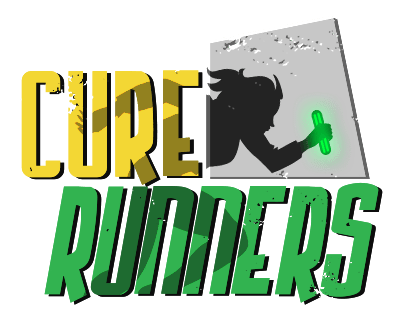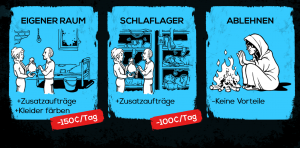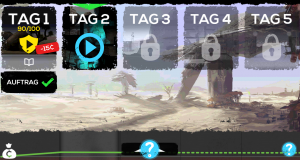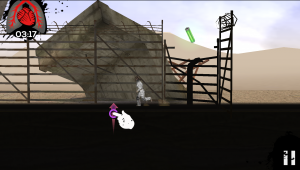CURE Runners is an e-learning game developed by the Austrian developer agency OVOS. It aims to teach players about money management using the redeemable points of the game as a virtual economy. Which will already sound familiar to anyone who read the previous blogpost, discussing the most common game mechanics. In this post I want to have look at if and how CURE Runners, incorporated these mechanics:
So in CURE Runners, there are two point systems: Cure Points as a digital currency, meaning the player needs Cure points to purchase things inside the game. Since the main purpose of the game is to improve players‘ understanding of how money works there is a big emphasis on keeping track of the Cure Points. As seen in the picture bellow, between the levels the player has to take various decisions if and how much cure he would like to spend (or how much he can afford to spend), each decision will then influence the player’s performance during the next level. The second point system are the Shields which are the game’s skill points. With more Shields the player will rise a rank which will allow him/her to play challenges beside the main storyline.
(fig.: OVOS, „CURE Runners“, Deciding about Accommodation)
The game levels of CURE Runners would be the „days“ as each day has its own challenge which seem to increase slightly in difficulty. A certain amount of levels or days then in turn make up a chapter which in turn are only there to create more depth as the story moves forward and they play in different settings.
(fig.: OVOS, „CURE Runners“, Level Overview)
There does not seem to be a leaderboard, however, at the end of each level the player’s personal high-score on this particular level is shown so players can compete agains themselves.
Arguably the skills which can be unlocked in the game can be seen as badges as they serve as an additional motivator and seem to be earned randomly throughout the levels. Since they are skills, they can also be put to use during challenges but only in exchange for Cure Points. Thus players need to evaluate if the skills advantage is worth the extra cost. Sensitizing them towards the desired learning outcome.
(fig.: OVOS, „CURE Runners“, Skill Badges)
CURE Runners‘ onboarding process was very straight forward there was a little bit of animated backstory and then the game already started with the first level. As depicted bellow, during the level there were a few arrows accompanied with a short explanation, whenever a new action was required. After completing the first level the dashboard was shown the first time and there too the information was kept to a minimum. This way the onboarding feels rather natural and the player really gets eased into the game.
(fig.: OVOS, „CURE Runners“, Explanatory Arrows)
In CURE Runners the levels and side challenges are not even working towards the learning goal. In both the player simply collects items. All the decisions the player takes in-between the challenges is where the money management and mindful spending supposedly gets trained. The challenges are thus only there to make the game more engaging and add to the intended experience. Personally I think this might be the one point that could probably be improved to work more towards the desired learning outcomes. Although to the developers‘ credit, I only completed the first chapter so they might have introduced more details in the later levels.
I would say the game definitely has an engagement loop, just excluding the social call to action. Personally I don’t mind this as I don’t like having to share anything about games or other activities. I can see however, how especially over a longer time span it would get a lot more engaging if there were social interaction with other players.
Sources:
- OVOS, CURE Runners, https://ovos.at/de/projekte/cure-runners-ein-spiel-uber-geld-ohne-geld/
- Zichermann, Gabe; Cunningham, Christopher; Gamification by Design: Implementing Game Mechanics in Web and Mobile Apps, O’Reilly Media, 2011




